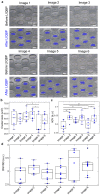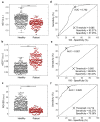Early Predictor Tool of Disease Using Label-Free Liquid Biopsy-Based Platforms for Patient-Centric Healthcare
- PMID: 35159085
- PMCID: PMC8834418
- DOI: 10.3390/cancers14030818
Early Predictor Tool of Disease Using Label-Free Liquid Biopsy-Based Platforms for Patient-Centric Healthcare
Abstract
Cancer cells undergo phenotypic changes or mutations during treatment, making detecting protein-based or gene-based biomarkers challenging. Here, we used algorithmic analysis combined with patient-derived tumor models to derive an early prediction tool using patient-derived cell clusters from liquid biopsy (LIQBP) for cancer prognosis in a label-free manner. The LIQBP platform incorporated a customized microfluidic biochip that mimicked the tumor microenvironment to establish patient clusters, and extracted physical parameters from images of each sample, including size, thickness, roughness, and thickness per area (n = 31). Samples from healthy volunteers (n = 5) and cancer patients (pretreatment; n = 4) could be easily distinguished with high sensitivity (91.16 ± 1.56%) and specificity (71.01 ± 9.95%). Furthermore, we demonstrated that the multiple unique quantitative parameters reflected patient responses. Among these, the ratio of normalized gray value to cluster size (RGVS) was the most significant parameter correlated with cancer stage and treatment duration. Overall, our work presented a novel and less invasive approach for the label-free prediction of disease prognosis to identify patients who require adjustments to their treatment regime. We envisioned that such efforts would promote the management of personalized patient care conveniently and cost effectively.
Keywords: algorithmic analysis; disease prognosis; label free; patient-derived cell clusters; personalized patient care.
Conflict of interest statement
One or more authors have a patent related to this work.
Figures






Similar articles
-
Novel secretome-to-transcriptome integrated or secreto-transcriptomic approach to reveal liquid biopsy biomarkers for predicting individualized prognosis of breast cancer patients.BMC Med Genomics. 2019 May 30;12(1):78. doi: 10.1186/s12920-019-0530-7. BMC Med Genomics. 2019. PMID: 31146747 Free PMC article.
-
Overview of resistance to systemic therapy in patients with breast cancer.Adv Exp Med Biol. 2007;608:1-22. doi: 10.1007/978-0-387-74039-3_1. Adv Exp Med Biol. 2007. PMID: 17993229 Review.
-
Toward Microfluidic Label-Free Isolation and Enumeration of Circulating Tumor Cells from Blood Samples.Cytometry A. 2019 Oct;95(10):1085-1095. doi: 10.1002/cyto.a.23868. Epub 2019 Jul 31. Cytometry A. 2019. PMID: 31364817
-
Pretherapeutic evaluation of patients with upper gastrointestinal tract cancer using endoscopic and laparoscopic ultrasonography.Dan Med J. 2012 Dec;59(12):B4568. Dan Med J. 2012. PMID: 23290296 Review.
-
A pilot study of next generation sequencing-liquid biopsy on cell-free DNA as a novel non-invasive diagnostic tool for Klippel-Trenaunay syndrome.Vascular. 2021 Feb;29(1):85-91. doi: 10.1177/1708538120936421. Epub 2020 Jun 26. Vascular. 2021. PMID: 32588787
Cited by
-
A Novel Hand-Held Spinning Platform with Centrifugal Microfluidics for Rapid, Cost-Effective Urinary Total Protein Detection at the Point of Care.Anal Chem. 2025 Jul 22;97(28):15049-15059. doi: 10.1021/acs.analchem.5c00930. Epub 2025 Jul 8. Anal Chem. 2025. PMID: 40628647 Free PMC article.
-
Label-free liquid biopsy through the identification of tumor cells by machine learning-powered tomographic phase imaging flow cytometry.Sci Rep. 2023 Apr 13;13(1):6042. doi: 10.1038/s41598-023-32110-9. Sci Rep. 2023. PMID: 37055398 Free PMC article.
-
Microfluidics-based patient-derived disease detection tool for deep learning-assisted precision medicine.Biomicrofluidics. 2024 Jan 12;18(1):014101. doi: 10.1063/5.0172146. eCollection 2024 Jan. Biomicrofluidics. 2024. PMID: 38223546 Free PMC article.
-
3D Biomimetic Models to Reconstitute Tumor Microenvironment In Vitro: Spheroids, Organoids, and Tumor-on-a-Chip.Adv Healthc Mater. 2023 Jul;12(18):e2202609. doi: 10.1002/adhm.202202609. Epub 2023 Mar 29. Adv Healthc Mater. 2023. PMID: 36917657 Free PMC article. Review.
-
Simplifying the complex: accessible microfluidic solutions for contemporary processes within in vitro diagnostics.Lab Chip. 2022 Sep 13;22(18):3340-3360. doi: 10.1039/d2lc00609j. Lab Chip. 2022. PMID: 35984715 Free PMC article. Review.
References
Grants and funding
LinkOut - more resources
Full Text Sources

